2. 云南省地质调查院, 昆明 650216
2. Yunnan Institute of Geology and Mineral Resources Exploration, Kunming 650216, China
中国西南三江特提斯处于全球特提斯构造域东段,完整地记录了冈瓦纳与潘吉亚大陆裂解-增生和欧亚大陆聚合演化历史(Cawood and Buchan, 2007; Cawood and Korsch, 2008; Cawood et al., 2013; Cocks and Torsvik, 2013; Condie and Kröner, 2013; Deng et al., 2014a, b)。昌宁-孟连缝合带作为西南三江主要缝合带之一,主要经历了晚古生代-中生代古特提斯洋扩张、消减与闭合构造演化过程(Fang and Niu, 2003; Heppe et al., 2007; Sone and Metcalfe, 2008; Hennig et al., 2009; Jian et al., 2009; Wang et al., 2013, 2015b; 陈福川等, 2015; 邓军等, 2016)。昌宁-孟连缝合带是研究古特提斯洋消减过程的天然实验室:缝合带内大芒光房地区发育ca.270Ma的SSZ型蛇绿岩套(Jian et al., 2009),缝合带东侧产出与之平行的高压变质岩带,以花岗质岩类为主的巨型岩基即临沧岩基(Hennig et al., 2009; 孔会磊等, 2012; Dong et al., 2013; Wang et al., 2015a; Deng et al., 2017)与双峰式火山岩带(Peng et al., 2013),并且随着特提斯洋的演化,发生了一些列的成矿作用(张静等, 2010; Wang et al., 2014b, 2016a; Li et al., 2015; Chen et al., 2017; Deng et al., 2017)。其中位于南澜沧江带的临沧花岗岩,是区域出露面积最大的复式岩基,其花岗岩类型和岩石成因都十分复杂,是了解古特提斯洋俯冲和碰撞的关键地质记录,然而,临沧花岗岩的成因类型和构造背景仍然存在很大争议(Metcalfe, 1988, 1996, 2002, 2011; 施小斌等, 2006; 刘德利等, 2008; Hennig et al., 2009; 孔会磊等, 2012; Dong et al., 2013; Peng et al., 2013; 廖世勇等, 2014; Wang et al., 2015a; Deng et al., 2017)。前人把临沧岩基解释成岩浆弧(Sone and Metcalfe, 2008)或者外来岩体(杨振德, 1995, 1996),目前证据认为其大地构造背景为古特提斯洋俯冲到闭合时,发生同碰撞造山和后碰撞伸展作用生成(Zhu et al., 1999; Henning et al., 2009; Fan et al., 2010; 孔会磊等, 2012; Dong et al., 2013; Wang et al., 2014a, 2015a; Deng et al., 2017),但临沧花岗岩在构造演化过程中的岩石成因与构造意义仍需讨论。
本文基于详细的岩石学和地球化学资料,对临沧花岗岩的岩石成因和物质源区进行系统分析,结合前人发表的数据和研究成果,临沧花岗岩可根据源区深度、侵位年龄、地球化学特征和同位素差异等进行从南到北的对比。利用锆石U-Pb测年和Hf同位素数据,并结合昌宁-孟连缝合带区域沉积地层、平掌组火山岩、高压变质片岩、勐库榴辉岩(徐桂香等, 2016; 李静等, 2017)等,对临沧花岗岩基的结晶年龄、岩石成因类型、源区性质和古特提斯洋闭合演化等进行讨论。
1 地质背景与样品昌宁-孟连缝合带处于西南三江特提斯造山带南段,其介于东侧思茅地块和西侧保山地块之间,呈现出一条长约200km,宽5~30km的南北向狭长条带(图 1;Sone and Metcalfe, 2008)。
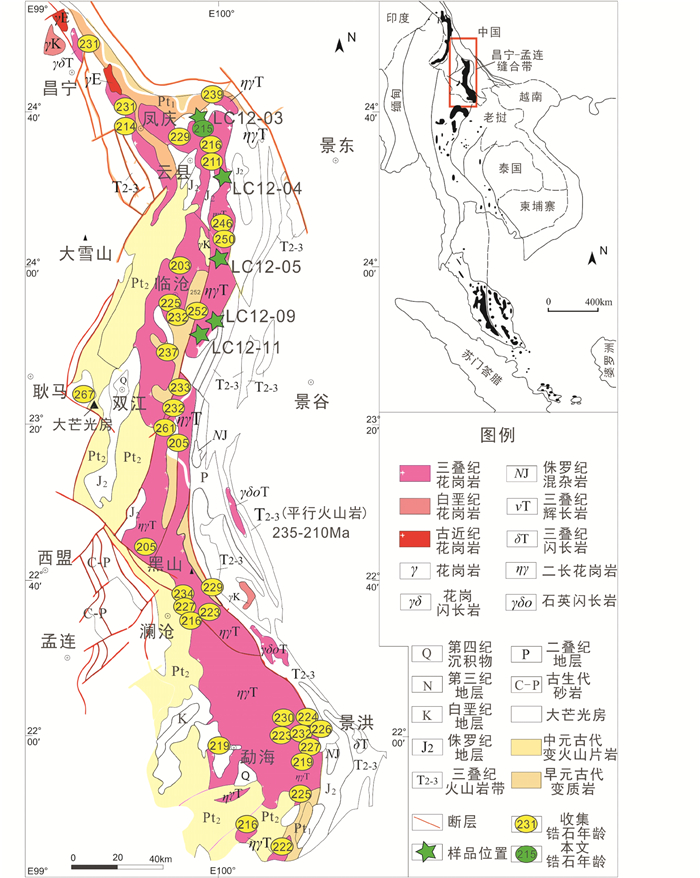
|
图 1 三江特提斯昌宁-孟良缝合带临沧花岗岩基构造带简略图(据云南省地质矿产局, 1990改编; Dong et al., 2013) 昌宁-孟良缝合带临沧花岗岩基锆石年龄数据引自: 彭头平等(2006), 施小斌等(2006), Henning et al. (2009), 聂飞等(2012), 孔会磊等(2012), Dong et al. (2013), Peng et al. (2013), 王舫等(2014), Wang et al. (2015a)和Deng et al. (2017) Fig. 1 Simplified geological map of the Changning-menglian zone Lincang granite foundation in the Sanjiang Tethyan domain (modified after BGMRY, 1990; Dong et al., 2013) |
临沧岩基是昌宁-孟连缝合带东侧思茅地块西缘发育的以花岗岩类岩石为主体的巨型复式岩基,呈南北向延伸,南北长约350km,东西宽10~48km,出露面积达7400km2,在三江地区整体呈“Z”字形展布(图 1),岩基发育不同时代的花岗岩体(261~203Ma),呈现侵入式接触关系。在古特提斯洋缝合带中,部分学者认为临沧岩基系三江特提斯北段白马雪山、东达山和吉塘花岗岩质岩基(株)的南延部分(Tao et al., 2014; Peng et al., 2014; 简平等, 2003);南部与滇缅泰马地块的花岗岩体链接,构建了一条横跨藏东、川西、滇西、泰国和马来西亚的巨型花岗岩脉(Metcalfe, 2011)。
临沧岩基以花岗岩类岩石为主,岩性复杂多变。本文样品采自临沧岩基中北部,包括凤庆、云县和临沧地区,共5件新鲜样品(LC12-03、-04、-05、-09和-11)。花岗岩的岩石类型主要是中细粒-中粒花岗闪长岩和黑云母二长花岗岩,花岗闪长岩野外风化面浅灰色,新鲜岩石呈现灰色,中细粒花岗结构,块状构造;花岗岩内部包含闪长质包体,可能在母岩浆源区发生一定程度的岩浆混合作用。在电子显微镜下观察(图 2),主要矿物为石英(20%~30%)、钾长石(10%~15%)、斜长石(35%~40%)、黑云母(5%~10%)和角闪石(8%~15%),副矿物包括锆石、磷灰石、榍石、褐帘石和钛铁矿。黑云母二长花岗岩主要矿物为钾长石(30%~35%)、斜长石(25%~30%)、石英(30%~35%)、黑云母(<5%)、白云母(<5%),副矿物包括锆石、磷灰石和钛铁矿。石英在镜下观察一般呈他形粒状结构,1~3mm,发育裂隙正交光下波状消光。钾长石为正长石和微斜长石两种,半自形-他形板状,大小为1~4mm,发育卡氏双晶。斜长石大多呈自形板状结构,大小0.5~3mm不等,聚片双晶,无明显环带。黑云母为半自形-自形片状多色性明显。

|
图 2 滇西临沧二长花岗岩手标本及显微照片 (a)手标本闪长质包体;(b)石英,具波状消光; 斜长石卡氏双晶;(c)钾长石、斜长石、石英和黑云母斑晶;(d)斜长石斑晶条纹双晶;板片状黑云母(b-d均为正交镜下照片).Qz-石英;Bt-黑云母;Pl-斜长石 Fig. 2 Hand specimen photograph (a) and microphotographs (b-d) of the Lincang monzonite granite, western Yunnan Province |
5件样品在河北省廊坊市地科勘探技术服务有限公司依次进行光薄片、探针片和圆光片的磨制加工。然后将花岗岩样品粉碎并且研磨至200目,取60g粉末进行主、微量元素实验测试。主量元素测试采用X荧光光谱法(XRF)上机分析,分析结果的不确定度为0.1%~1.0%,满足实验精度要求;微量元素采用电感耦合等离子质谱法(ICP-MS)上机分析,测试精度优于2×10-6。主、微量元素测试均在长安大学完成,具体测试操作流程见Qi et al. (2000),样品的溶解处理、精密度分析和准确度见Liu et al. (2008)。
选取1件样品(LC12-03)进行锆石U-Pb年代学以及Hf同位素分析。锆石分选工作在河北省廊坊市地科勘探技术服务有限公司完成。具体操作流程:首先将花岗岩样品按照指定粒度粉碎后,经清洗、烘干和筛选,然后采用磁选和重液分离技术将锆石从矿物中选出,最后在双目镜下人工进行提纯,挑选晶型完整、粒度较大、无明显裂隙和包裹体的锆石。制靶工作是在锆年领航科技服务公司完成,并在其电镜室内进行锆石阴极发光(CL)高清图像采集,以观察其内部结构(图 3)。锆石U-Pb年龄在中国地质大学(武汉)地质过程与矿产资源国家重点实验室利用LA-ICPMS仪器进行测定,分析是采用10Hz的激光频率,193nm的激光波长,36μm直径的激光束预剥蚀15s,然后实际测试的剥蚀时间为45s。利用CL图像以及已有U-Pb年龄的点位确定Hf同位预素测试点,并采用其国家重点实验室LA-MC-ICPMS仪器进行锆石Hf同位素分析。运用ICPMSDataCal 10.0软件对锆石U-Pb年龄以及Hf同位素数据进行离线处理,具体实验操作流程与数据处理方法见Liu et al.(2008, 2010a, b)。

|
图 3 滇西临沧二长花岗岩代表性锆石颗粒阴极发光照片 红色圈代表年龄测试点位;黄色圈代表Hf同位素测试点位 Fig. 3 Cathodoluminescence (CL) images of representative zircon grains from the Lincang monzonite gtanite, western Yunnan Province |
本文对凤庆县1件临沧花岗岩的二长花岗岩样品(LC15-03)进行锆石LC-ICP-MS U-Pb定年,分析结果见表 1。锆石颗粒自形程度高,多为规则的长柱状,部分短柱状,半自形-自形晶体,长60~150μm,长宽比1.5: 1~3: 1。阴极发光图像中可见锆石震荡环带发育明显(图 3);锆石的U含量765×10-6~6190×10-6,Th含量305×10-6~2247×10-6,测试样品的锆石Th/U比值基本大于0.1(Th/U集中0.15~0.65),为典型的岩浆锆石特征(Hoskin and Black, 2003)。在测试分析过程中,选择锆石边部环带打点,共测试26个分析点,去除锆石继承核年龄和含有包体锆石年龄,剩下23点进行加权年龄分析。
|
|
表 1 滇西临沧二长花岗岩锆石LA-ICPMS分析结果 Table 1 LA-ICPMS zircon U-Pb analytical data of the Lincang monzonite granite, western Yunnan Province |
获锆石U-Pb年龄数据后得到样品中剩余测试点206Pb/238U加权年龄为215.5±0.4Ma(MSWD=2.8)(图 4),在锆石U-Pb年龄协和图上分析点均分布在协和线上或其附近,总体显示良好的协和性,表明锆石形成后处于封闭体系,无明显U或者Pb加入和带出。因此,该年龄结果代表了岩浆岩的就位时代。

|
图 4 滇西临沧二长花岗岩LA-ICMPS锆石U-Pb加权年龄图 Fig. 4 LA-ICMPS zircon U-Pb weighted age diagram for the Lincang monzonite granite, western Yunnan Province |
本文临沧花岗岩基样品岩石地球化学结果(表 2)显示,临沧花岗岩类主微量元素存在一定的成分变化。在主量元素中SiO2(67.54%~70.57%,均值68.89%)、Al2O3(13.85%~15.05%,均值14.6%)、较高的Na2O+K2O(5.75%~7.70%,均值6.74%)含量,MgO(1.18%~2.19%,均值1.61%)和TiO2(0.41%~0.69%,均值0.53%)含量较低,具有高硅富铝富碱的特征。在标准矿物ANOR-Q判别图中,样品主要投在二长花岗岩和花岗闪长岩区域(图 5a),与前人判别岩性基本一致(Zhu et al., 1999; Henning et al., 2009; Fan et al., 2010; 孔会磊等, 2012; Dong et al., 2013; Wang et al., 2015a; Deng et al., 2017);K2O(3.50%~5.04%)、Na2O/K2O(1.27~1.89、平均值:1.60)比值较高,因此,样品属于高钾钙碱性-钾玄质花岗岩,在SiO2-K2O图中临沧花岗岩整体投在高钾钙碱性系列区域(图 5c);样品的铝饱和指数(A/CNK)为1.1~1.2,表现出过铝质花岗岩特征(图 5b),刚玉分子指数(C)较大为1.53~2.49;样品分异指数(DI)为73.62~82.35。
|
|
表 2 滇西临沧花岗岩主量元素(wt%)和微量元素(×10-6)分析结果 Table 2 Major (wt%) and trace elements (×10-6) of the Lincang monzonite granite, western Yunnan Province |

|
图 5 地球化学判别图解 Q-ANOR标准成分图解(a)和A/NK-A/CNK判别图(b)(据Kemp and Hawkesworth, 2003);(c) SiO2-K2O判别图(据Peccerillo and Taylor, 1976);(d) Na2O-K2O判别图(Turner et al., 1996).区域花岗岩岩体数据来自彭头平等(2006), 施小斌等(2006), Henning et al. (2009), 聂飞等(2012), 孔会磊等(2012), Dong et al. (2013), Peng et al. (2013), 王舫等(2014), Wang et al. (2015a), Deng et al. (2017)等; 图 7-图 11数据来源同此图 Fig. 5 Discrimination diagrams for the Lincang granodiorite and monzonite granite, western Yunnan Province |
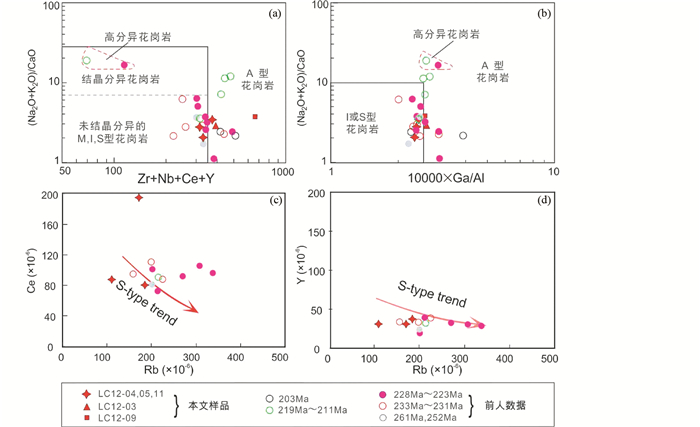
|
图 7 滇西临沧花岗闪长岩和二长花岗岩成因判别图 (a, b, 据Whalen et al., 1987; c, d, 据Chappell, 1999) Fig. 7 Discrimination diagrams for the genetic types of the Lincang granodiorite and monzonite granite (a, b, after Whalen et al., 1987; c, d, after Chappell, 1999) |
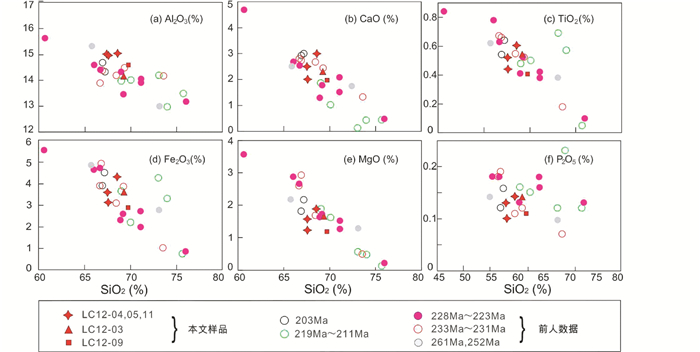
|
图 8 滇西临沧花岗闪长岩和二长花岗岩主量哈克图 Fig. 8 Harker diagrams for the major element of the Lincang granodiorite and monzonite granite |
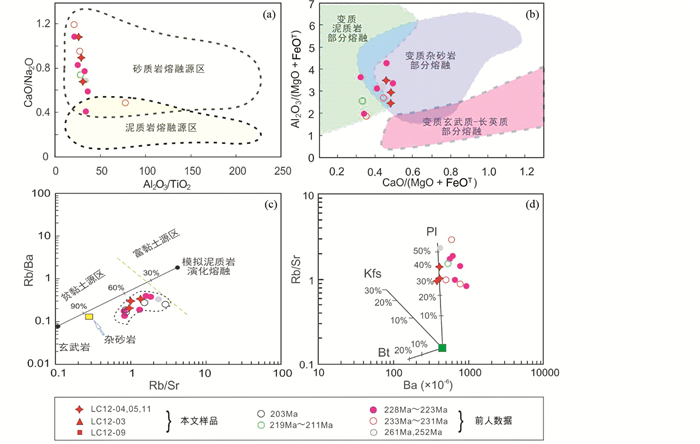
|
图 9 滇西临沧花岗闪长岩和二长花岗岩岩浆源区判别图 Fig. 9 Discrimination diagrams for the potential magma source of the Lincang granodiorite and monzonite granite (a) CaO/Na2O vs. Al2O3/TiO2 diagram (Sylvester, 1998); (b) molar Al2O3/(MgO+FeOT) vs. CaO/(MgO+FeOT) (Altherr et al., 2000); (c) Rb/Sr vs. Rb/Ba diagram (Sylvester, 1998); (d) Rb/Sr vs. Ba during partial melting. The solid-liquid partition coefficients used in the calculations are from Icenhower and London(1995, 1996), Nash and Crecraft (1985), and Nabelek and Bartlett (1998). Pl-plagioclase; Kfs-K-feldspar; Bt-biotite |
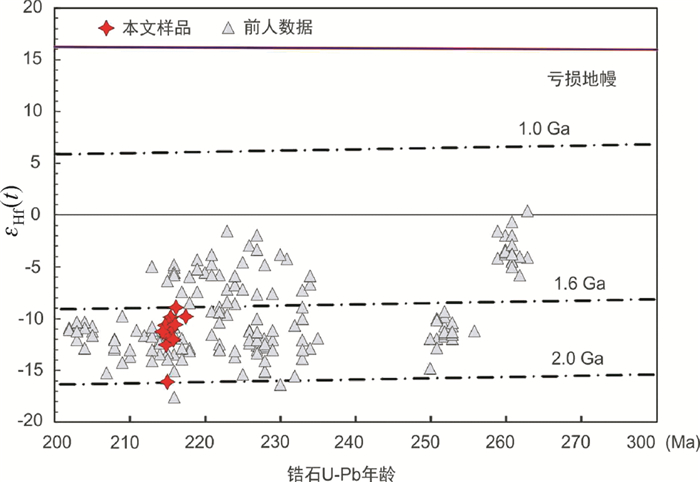
|
图 10 滇西临沧二长花岗岩岩锆εHf(t)值与U-Pb年龄图解 Fig. 10 Plots of zircon U-Pb ages vs. εHf(t) values for the Lincang monzonite granite, western Yunnan Province |
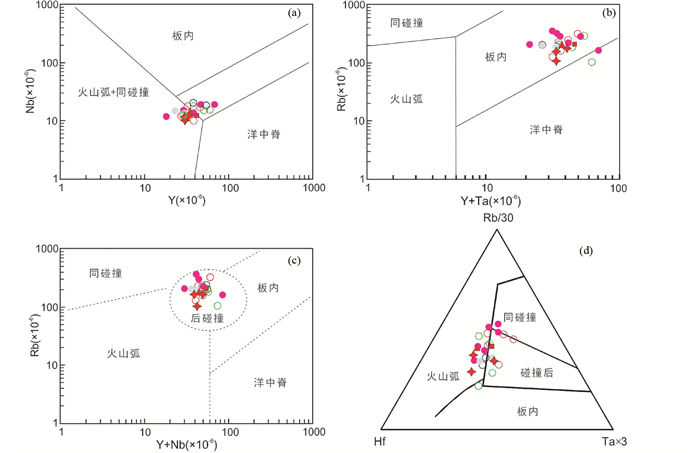
|
图 11 滇西临沧花岗闪长岩和二长花岗岩构造判别图解 Fig. 11 Geochemical discrimination diagrams of Lincang granodiorite and monzonite granite Nb vs. Y (a), Rb vs. Yb+Ta (b) and Rb vs. Y+Nb (c) (Pearce et al., 1984; Pearce, 1996) and Rb-Hf-Ta (d, Harris et al., 1986) |
临沧花岗岩全岩微量元素结果(表 2)显示,微量元素具有相似的配分特征,但具体含量差别较大。样品全稀土元素(∑REE)分布值为194.9×10-6~819.0×10-6,在稀土元素球粒陨石标准化配分图中(图 6a),具有明显的右倾特征,(La/Yb)N为6.36~33.5,轻重稀土元素分异程度较高,δEu=0.19~0.57,具有明显的Eu异常,δCe=0.99~1.04,无Ce异常。在微量元素蜘蛛图中(图 6b),高Rb、Th、U、Pb和Sm含量,低的Sr、P、Nb、Ta、Zr、Hf和Ti含量,与典型的地壳源区岩浆特征相似(Harris et al., 1986; Chappell and White, 1974, 1992; Bea et al., 2011),指示了花岗质岩浆主要源于地壳部分熔融;明显的Sr和Ba的负异常暗示了斜长石和角闪石在岩浆源区残余或者存在两者的早期结晶分异,在蜘蛛图中Nb和Ta表现了典型钙碱性岩浆特征。综合微量元素来看,全岩微量整体显示轻稀土元素富集,重稀土元素亏损,富集大离子亲石元素,亏损高场强元素的特征。

|
图 6 滇西临沧花岗闪长岩和二长花岗岩球粒陨石标准化稀土元素配分曲线(a)和原始地幔标准化微量元素蛛网图(b)(标准化值据Sun and McDonough, 1989) Fig. 6 Chondrite-normalized REE patterns (a) and primitive mantle-normalized trace element patterns (b) for the Lincang granodiorite and monzonite granite, western Yunnan Province (normalization values after Sun and McDonough, 1989) |
选取12个有效锆石U-Pb年龄分析点进行Hf同位素分析,结果显示176Yb/177Hf=0.0156~0.0533,176Lu/177Hf=0.0005~0.0018 (表 3),所有分析点176Lu/177Hf<0.002,指示了这些锆石在形成以后,没有放射性成因Hf的积累,可用初始176Hf/177Hf比值代表锆石形成时的176Hf/177Hf比值(吴福元等, 2007)。样品的fLu/Hf范围为-0.98~-0.96之间,平均值为-0.96,与镁铁质地壳的fLu/Hf(-0.34, Amelin et al., 2000)和硅铝质地壳的fLu/Hf (-0.72, Vervoort et al., 1996)相比更低,因此阶段模式年龄反映源区物质从亏损地幔被抽取的时间。分析点εHf(t)值均为较明显的负值(-15.9~-9.08),对应地壳模式年龄tDM2集中在1.6~2.0Ga。
|
|
表 3 临沧二长花岗岩锆石Hf同位素 Table 3 Zircon Hf isotopic data of the Lincang monzonite granite, western Yunnan Province |
临沧花岗岩基是古特提斯洋消减作用的产物。随着近十多年同位素定年技术的发展,逐渐积累了一批可靠的锆石U-Pb年龄结果。前人锆石LA-ICP-MS U-Pb定年结果显示:岩基最北端癞痢头山的二长花岗岩时代为231.5±3.6Ma(聂飞等, 2012),凤庆二长花岗岩时代为231.8±1.4Ma(Dong et al., 2013),临沧岩体北段小湾公路黑云母二长花岗岩年龄为230.4±3.6Ma(彭头平等, 2006),临沧市北侧二长花岗岩锆石LA-ICP-MS U-Pb定年结果为203.3±0.7Ma(Dong et al., 2013),临沧南侧花岗闪长岩年龄为252±1Ma(Deng et al., 2017),澜沧北部黑山花岗闪长质-花岗质岩石8件样品定年结果为232.9±1.7Ma~216.6±1.6Ma(王舫等, 2014; 孔会磊等, 2012),景洪西侧花岗岩年龄为232±2Ma~219.7±0.7Ma(彭头平等, 2006; Dong et al., 2013; 王舫等, 2014),临沧岩基最南端高分异花岗岩2个样品锆石时代为216±3Ma和228±3Ma(Wang et al., 2015a)。
综合前人结果,临沧岩基侵位时代在261~203Ma,集中于230~210Ma,峰值~220Ma。反映岩浆岩主体侵位于中晚三叠世,有少量晚二叠世岩浆活动记录。根据分布特征,将岩浆活动划分为5个阶段:第一阶段261~253Ma,第二阶段233~231Ma,第三阶段228~223Ma,第四阶段219~211Ma,第五阶段205~200Ma。明显间断的年龄分布模式反映岩浆活动可能是非连续性的,在古特提斯洋消减过程中岩浆活动呈现间歇活动特征。本研究获取临沧岩基中部凤庆地区黑云母二长花岗岩锆石LA-ICP-MS U-Pb加权年龄为215.5±0.4Ma(n=23, MSWD=2.8),与临沧岩基主体侵位时代一致。
4.2 岩石成因类型花岗岩按成因类型可划分为I、S、M和A型(Chappell and White, 1974, 1992; Bonin, 2007)。I型花岗岩是由火山岩或变火山岩为岩浆源区,在I型花岗岩中,特征性的矿物为角闪石,K2O/Na2O比值一般低于1,铝饱和指数(A/CNK)<1.1,CIPW刚玉分子指数<1%(Clemens et al., 2011; Chappell et al., 2012);S型花岗岩岩浆源区为变沉积岩,在S型花岗岩中,特征性次要矿物为堇青石、石榴石和夕线石,K2O/Na2O比值一般高于1,铝饱和指数(A/CNK)>1.1,CIPW刚玉分子指数>1%;M型花岗岩是由俯冲大洋地壳或者上覆地幔衍化而来,具有较低K2O(通常<1%)为特征(Chappell, 1999; Healy et al., 2004);A型花岗岩指示了非造山期、沿着裂谷带无水事件和稳定大陆壳中的花岗岩,在A型花岗岩中,条纹碱性长石十分常见,此类型花岗岩基于构造环境和化学特征识别,并且发育碱性暗色矿物为特征(Bonin, 2007; Robert, 2006; Grebennikov, 2014; Wang et al., 2016b)。
本文测试的5件样品在显微镜下可见明显的白云母,样品的铝饱和指数(A/CNK)为1.1~1.2,刚玉分子指数(C)较大为1.53~2.49,表现出过铝质花岗岩特征。
进一步对临沧岩基目前有确切年龄的花岗岩样品进行岩石成因判别(图 7a-d)。综合分析前人临沧基岩花岗岩年龄与全岩数据结果显示,在261~225Ma,样品点投在Zr+Nb+Ce+Y数值<350×10-6,(Na2O+K2O)/CaO值<50区域(图 7a, b),属于未结晶分异的I或S型花岗岩,但具体哪种成因花岗岩需要进一步讨论。在~232Ma之后,花岗岩类开始投入Zr+Nb+Ce+Y数值>350×10-6区域,开始具有A型花岗岩特征;在224~203Ma期间,成因判别图中临沧花岗岩样品点主要以A型花岗岩为主。(Na2O+K2O)/CaO大于50时为高分异花岗岩,指示临沧花岗岩中发育分异指数(DI)大于92的高分异花岗岩(Wang et al., 2015a),综上分析,临沧花岗岩为一个岩石成因复杂的复式岩基,随着古特提斯洋闭合、同碰撞和后碰撞构造演化阶段的进行,发生一系列的岩浆作用和深部地壳响应,由于构造背景、源区性质和演化阶段的差异,生成了较为齐全的花岗岩成因类型。
在花岗岩成因判别中,临沧花岗岩年龄在261~225Ma期间,全岩地球化学Zr+Nb+Ce+Y数值小于350×10-6,(Na2O+K2O)/CaO值小于50时,属于未结晶分异的M、I或S型花岗岩,但具体哪种成因类型的花岗岩需结合岩石学、地球化学等方法综合分析。在261~225Ma期间的花岗岩样品中,2件样品(Peng et al., 2013; Deng et al., 2017)铝饱和指数(A/CNK)<1.0,具有偏铝质特征,硬玉分子指数(C)<0.15远远小于1.0,石英含量较少,暗色矿物为角闪石具有I型花岗岩特征;除去A型和I型花岗岩样品,对剩下样品进行分析,在Rb-Y和Rb-Ce Harker图中(图 7c, d),整体的Y含量较低,符合S型花岗岩特征,除此之外,剩余样品的普遍特征:具有高的铝饱和指数(A/CNK>1.0),属于准铝质到过铝质,刚玉分子指数(C)范围:1.21%~2.53%,均大于1%,K2O/Na2O比值范围1.43~2.11,均大于1;样品K2O(3.50%~5.43%)含量较高,且样品中的暗色矿物主要为黑云母,未见角闪石,因此不会是M型或I型花岗岩,并且在ACF(A=Al2O3-(Na2O+K2O)、F=FeO+MgO和C=CaO)判别图中,样品点均落在S型花岗岩区域,为典型的过铝质S型花岗岩。
4.3 岩浆源区在哈克图解中的地球化学变化阐明临沧花岗岩成分是不同于其源区(图 8),图中岩浆演化随着SiO2含量的升高,Al2O3、CaO、TiO2、Fe2O3和MgO等体现一个负相关的趋势,表明了在分离结晶过程中的连续成分变化。从260~200Ma,年龄越往后,岩石越偏向高Si淡色花岗岩,也就是图上看到的分异程度升高或者部分熔融程度降低。在岩石地球化学中,261~225Ma期间的临沧花岗岩样品属于过铝质钙碱性系列,有较高的K2O/Na2O比值,通过地球化学、同位素证据和实验岩石学的约束过铝质花岗岩起源于地壳的重融(Miller, 1985; Sylvester, 1989, 1998)。并且,在微量元素中富集Rb、Th、U、和Pb, 亏损Ba、Nb、Sr和Ti,这些化学特征与壳源熔融相似(Harris et al., 1986; Liu et al., 1989; Chappell and White, 1992; Bea et al., 2011),地壳基底物质熔融花岗岩锆石Hf同位素一般呈现较明显的负值,是否含有地幔物质加入需进一步讨论。
S型花岗岩源区主要为变沉积岩源区,例如:变杂砂岩和变泥质岩(Brown, 2013)。实验研究显示在花岗质岩浆中CaO/Na2O比值主要受源区成分的影响(Jung and Pfander, 2007),源于变杂砂岩衍化的岩浆CaO/Na2O>0.3,平均值为0.8(Skjerlie and Johnston, 1996; Sylvester, 1998),源于变泥质岩的岩浆CaO/Na2O<0.5。261~225Ma期间的临沧花岗岩样品相比较于变泥质岩的岩浆源区普遍具有高CaO/Na2O(0.41~1.19)值和低的Al2O3/TiO2(21~78)值,表明母岩浆不是由变泥质岩部分熔融演化而来,在CaO/Na2O和Al2O3/TiO2图解中(图 9a),花岗岩样品大部分落在由变杂砂岩部分熔融的岩浆源区;变质杂砂岩演化的熔浆普遍具有低的Rb/Ba和Rb/Sr比值相较于变泥质岩熔浆(Harris and Inger, 1992; Miller, 1985),基于Rb/Ba和Rb/Sr比值投图,261~225Ma期间的临沧花岗岩样品投落在变质杂砂岩区域(图 9c);在CaO/(MgO+FeOT)和Al2O3/(MgO+FeOT)图中本文样品也主要落入变杂砂岩区域(图 9b),因此临沧岩基S型花岗岩主要源于变质杂砂岩的部分熔融。
长英质侵入岩中,Sr和Eu主要寄生在斜长石中,Ba主要寄存在钾长石中。Ca.261~225Ma期间的临沧花岗岩样品,Eu和Sr强烈亏损和Ba的轻微负异常指示了在部分熔融过程中,斜长石和钾长石是主要的残余相。使用实验测试的Rb、Sr和Ba通过固液相线的分配系数(Icenhower and London, 1995, 1996; Nabelek and Bartlett, 1998; Nash and Crecraft, 1985),利用大陆地壳的平均组成(Rudnick and Gao, 2003)作为初始组分,模拟了不同残余相(钾长石、斜长石和黑云母)在部分熔融实验中的影响(图 6d),结果显示了临沧花岗岩成分变化,在源区残留20%~60%的斜长石。
本文样品年轻锆石颗粒的εHf(t)均为负值(-15.9~-9.08),结合前人发表的临沧花岗岩锆石εHf(t)数据(Henning et al., 2009; 聂飞等, 2012; Dong et al., 2013; Peng et al., 2013; Wang et al., 2015a; Deng et al., 2017),得到εHf(t)值与U-Pb年龄图解(图 10),在图解中可以观测到,εHf(t)值由260~250Ma开始逐渐变负,指示了地幔物质成分减少,随后又在大约225Ma时εHf(t)趋向于0,说明地幔成分加入到临沧岩浆岩中,大约225~200Ma,εHf(t)值回归于-15~-10,暗示了古老地壳的重融,地幔物质作用较小。
4.4 构造意义昌宁-孟连古特提斯洋开启于泥盆纪,向东俯冲始于早二叠世,并于中晚三叠世闭合(图 11;Sone and Metcalfe, 2008; Deng et al., 2014a, b)。洋盆消减过程较为复杂,已发现的地质记录主要包括(图 1):(1)缝合带内部大芒光房揭示锆石U-Pb年龄为267Ma的SSZ型蛇绿岩套(Jian et al., 2009);(2)思茅地块西缘临沧地体发育与洋板片俯冲有关的高压变质岩带(最高至蓝片岩相),角闪石、蓝闪石和多硅白云母Ar-Ar年龄在293~279Ma(Zhang et al., 1993; Heppe et al., 2007; Fan et al., 2015);(3)思茅地块西缘南林山和半坡地区岛弧成因基性-超基性杂岩体锆石U-Pb年龄为295~288Ma(Hennig et al., 2009);(4)临沧花岗岩基锆石U-Pb年龄261~200Ma;(5)临沧岩基东侧与之平行的双峰式火山岩带锆石U-Pb年龄235~210Ma(Peng et al., 2008);(6)中三叠世上兰组底部发育底砾岩,并呈角度不整合覆盖于下伏古生代地层之上(杨学俊等,2012;Yang et al., 2014)。综合表明,古特提斯洋俯冲在~295Ma之前,三叠纪角度不整合的出现反应了与古特提斯洋盆闭合相关的造山作用,双峰式火山岩形成于伸展构造环境,其年代学数据指示后碰撞伸展作用伊始时代在中三叠世(~235Ma)(图 11)。根据Hf同位素年龄分布图(图 10),~230Ma,εHf(t)值升高早期存在地幔物质加入,指示发生俯冲带板片断离,地幔物质上涌,晚期加入量降低,进入后碰撞伸展阶段。~215Ma,εHf(t)值范围-15.9~-9.08,值进一步降低,指示了持续的后碰撞过程。因此,岩浆活动记录了古特提斯闭合过程,古特提斯洋闭合在~252Ma,碰撞造山过程:同碰撞造山(250~237Ma)和后碰撞伸展(235~203Ma)两种构造环境(图 11)。
5 结论(1) 本文的临沧花岗岩具有过铝质S型花岗岩特征,侵位年龄为215Ma,间断的年龄分布模式反映岩浆活动是非连续性的,在古特提斯洋消减过程中岩浆活动呈现间歇活动特征。
(2) 花岗岩体具有高硅富碱的特征。在261~225Ma, ,主要为过铝质S型花岗岩,同时也伴随着I型花岗岩产出,S型花岗岩源区为变杂砂岩熔融,源区有20%~60%斜长石的残留。在224~203Ma,主要以A型花岗岩为主。
致谢 本次研究的测试分析得到中国地质大学(武汉)地质过程与矿产资源国家重点实验室和长安大学国土资源部成矿作用及其动力学开放实验室工作人员的帮助;论文成文过程中得到中国地质大学(北京)王庆飞教授的指导,以及赵睿博士、陈福川博士、黄钰涵博士、李华健博士、刘金宇博士、于华之博士、王璇博士以及张琦玮硕士的帮助;在此一并表示衷心的感谢。
Altherr R, Holl A, Hegner E, Langer C and Kreuzer H. 2000. High-potassium, calc-alkaline I-type plutonism in the European Variscides:Northern Vosges (France) and northern Schwarzwald (Germany). Lithos, 50(1-3): 51-73. DOI:10.1016/S0024-4937(99)00052-3 |
Amelin Y, Lee DC and Halliday AN. 2000. Early-middle Archaean crustal evolution deduced from Lu-Hf and U-Pb isotopic studies of single zircon grains. Geochimica et Cosmochimica Acta, 64(24): 4205-4225. DOI:10.1016/S0016-7037(00)00493-2 |
Bea F, Mazhari A, Montero P, Amini S and Ghalamghash J. 2011. Zircon dating, Sr and Nd isotopes and element geochemistry of the Khalifan pluton, NW Iran:Evidence for Variscan magmatism in a supposedly Cimmerian superterrane. Journal of Asian Earth Sciences, 40(1): 172-179. DOI:10.1016/j.jseaes.2010.08.005 |
Blichert-Toft J, Chauvel C and Albarede F. 1997. Seperation of Hf and Lu for high-precision isotope analysis of rock samples by magnetic sector-multiple collector ICP-MS. Contributions to Mineralogy and Petrology, 127(3): 248-260. DOI:10.1007/s004100050278 |
Bonin B. 2007. A-type granites, related rocks:Evolution of a concept, problems and prospects. Lithos, 97(1-2): 1-29. DOI:10.1016/j.lithos.2006.12.007 |
Brown M. 2013. Granite:fromgenesis to emplacement. Bulletin of the Geological Society of America, 125(7-8): 1079-1113. DOI:10.1130/B30877.1 |
Bureau of Geology and Mineral Resources of Yunnan Province (BGMRY). 1990. Regional Geology of Yunnan Province. Beijing: Geological Publishing House.
|
Cawood PA and Buchan C. 2007. Linking accretionary orogenesis with supercontinent assembly. Earth-Science Reviews, 85(1-2): 82-83. DOI:10.1016/j.earscirev.2007.08.002 |
Cawood PA and Korsch RJ. 2008. Assembling Australia:Proterozoic building of a continent. Precambrian Research, 166(1-4): 1-35. DOI:10.1016/j.precamres.2008.08.006 |
Cawood PA, Wang YJ, Xu YJ and Zhao GC. 2013. Locating South China in Rodinia and Gondwana:A fragment of Greater India Lithosphere?. Geology, 41(8): 903-906. DOI:10.1130/G34395.1 |
Chappell BW and White AJR. 1974. Two contrasting granite types. Pacific Geology, 8: 173-174. |
Chappell BW and White AJR. 1992. I-and S-type granites in the Lachlan fold belt. Transactions of the Royal Society of Edinburg. Earth Sciences, 83(1-2): 1-26. DOI:10.1017/S0263593300007720 |
Chappell BW. 1999. Aluminium saturation in I-and S-type granites and the characterization of fractionated haplogranites. Lithos, 46(3): 535-551. DOI:10.1016/S0024-4937(98)00086-3 |
Chappell BW, Bryant CJ and Wyborn D. 2012. Peraluminous I-type granites. Lithos, 153(8): 142-153. |
Chen FC, Wang QF, Li GJ and Zhao Y. 2015. 40Ar-39Ar chronological and geochemical characteristics of Zhenyuan lamprophyres in Ailaoshan belt, western Yunnan. Acta Petrologica Sinica, 31(11): 3203-3216. |
Chen FC, Deng J, Shu QH, Li GJ, Cui XL, Zhao F and Wang QF. 2017. Geology, fluid inclusion and stable isotopes (O, S) of the Hetaoping distal skarn Zn-Pb deposit, northern Baoshan block, SW China. Ore Geology Reviews, 90: 913-927. DOI:10.1016/j.oregeorev.2016.10.013 |
Clemens JD, Stevens G and Farina F. 2011. The enigmatic sources of I-type granites:The peritectic connexion. Lithos, 126(3): 174-181. |
Cocks LRM and Torsvik TH. 2013. The dynamic evolution of the Palaeozoic geography of eastern Asia. Earth-Science Reviews, 117: 40-79. DOI:10.1016/j.earscirev.2012.12.001 |
Condie KC and Kröner A. 2013. The building blocks of continental crust:Evidence for a major change in the tectonic setting of continental growth at the end of the Archean. Gondwana Research, 23(2): 394-402. DOI:10.1016/j.gr.2011.09.011 |
Deng J, Wang QF, Li GJ, Li C and Wang CM. 2014a. Tethys evolution and spatialtemporal distribution of ore deposits in the Sanjiang region, southwestern China. Gondwana Research, 26(2): 419-437. DOI:10.1016/j.gr.2013.08.002 |
Deng J, Wang QF, Li GJ and Santosh M. 2014b. Cenozoic tectono-magmatic and metallogenic processes in the Sanjiang region, southwestern China. Earth-Science Reviews, 138: 268-299. DOI:10.1016/j.earscirev.2014.05.015 |
Deng J, Wang QF and Li GJ. 2016. Superimposed orogeny and composite metallogenic system:Case study from the Sanjiang Tethyan belt, SW China. Acta Petrologica Sinica, 32(8): 2225-2247. |
Deng J, Wang CM, Zi JW, Xia R and Li Q. 2017. Constraining subduction-collision processes of the Paleo-Tethys along the Changning-Menglian Suture:New zircon U-Pb ages and Sr-Nd-Pb-Hf-O isotopes of theLincang Batholith. Gondwana Research. |
Dong GC, Mo XX, Zhao ZD, Zhu DC, Goodman R, Kong HL and Wang S. 2013. Zircon U-Pb dating and the petrological and geochemical constraints on Lincang granite in western Yunnan, China:Implications for the closure of the Paleo-Tethys Ocean. Journal of Asian Earth Science, 62(62): 282-294. |
Fan WM, Wang YJ, Zhang AM, Zhang FF and Zhang YZ. 2010. Permian arc-backarc basin development along the Ailaoshan tectonic zone:Geochemical, isotopic and geochronological evidence from the Mojiang volcanic rocks, Southwest China. Lithos, 119(3-4): 553-568. DOI:10.1016/j.lithos.2010.08.010 |
Fan W, Wang Y, Zhang Y, Zhang Y, Jourdan F, Zi J and Liu H. 2015. Paleotethyan subduction process revealed from Triassic blueschists in the Lancang tectonic belt of Southwest China. Tectonophysics, 662(Special): 95-108. |
Fang N and Niu Y. 2003. Late Palaeozoic ultramafic lavas in Yunnan, SW China, and their geodynamic significance. Journal of Petrology, 44(1): 141-158. DOI:10.1093/petrology/44.1.141 |
Grebennikov AV. 2014. A-type granites and related rocks:Petrogenesis and classification. Russian Geology and Geophysics, 55(9): 1074-1086. DOI:10.1016/j.rgg.2014.08.003 |
Griffin WL, Wang X, Jackson SE, Pearson NJ, O'Reilly SY, Xu XS and Zhou XM. 2002. Zircon chemistry and magma mixing, SE China:In-situ analysis of Hf isotopes, Tonglu and Pingtan igneous complexes. Lithos, 61(3-4): 237-269. DOI:10.1016/S0024-4937(02)00082-8 |
Harris NBW, Pearce JA and Tindle AG. 1986. Geochemical characteristics of collisionzone magmatism. In: Coward MP and Ries AC (eds. ). Collision Tectonics. Geological Society of London, Special Publication, 67-81
|
Harris NBW and Inger S. 1992. Trace element modeling of pelite derived granites. Contributions to Mineralogy and Petrology, 110(1): 46-56. DOI:10.1007/BF00310881 |
Healy B, Collins WJ and Richards SW. 2004. A hybrid origin for Lachlan S-type granites:The Murrumbidgee batholith example. Lithos, 78(1): 197-216. |
Hennig D, Lehmann B, Frei D, Belyatsky B, Zhao XF, Cabral AR, Zeng PS, Zhou MF and Schmidt K. 2009. Early Permian seafloor to continental arc magmatism in the eastern Paleo-Tethys:U-Pb age and Nd-Sr isotope data from the southern Lancangjiang Zone, Yunnan, China. Lithos, 113(3-4): 408-422. DOI:10.1016/j.lithos.2009.04.031 |
Heppe K, Helmcke D and Wemmer K. 2007. The Lancang River zone of southwestern Yunnan, China:A questionable location for the active continental margin of Paleo-Tethys. Journal of Asian Earth Sciences, 30(5): 706-720. |
Hoskin PWO and Black LP. 2000. Metamorphic zircon formation by solid-state recrystallization of protolith igneous zircon. Journal of Metamorphic Geology, 18(4): 423-439. |
Icenhower J and London D. 1995. An experimental study of element partitioning among biotite, muscovite, and coexisting peraluminous silicic melt at 200MPa (H2O). American Mineralogist, 80(11-12): 1229-1251. DOI:10.2138/am-1995-11-1213 |
Icenhower J and London D. 1996. Experimental partitioning of Rb, Cs, Sr, and Ba between alkali feldspar and peraluminous melt. American Mineralogist, 81(5-6): 719-734. DOI:10.2138/am-1996-5-619 |
Jian P, Liu DY and Sun XM. 2003. SHRIMP dating of Baimaxueshan and Ludian granitoid batholiths, northwestern Yunnan Province, and its geological implications. Acta Geoscientica Sinica, 24(4): 337-342. |
Jian P, Liu DY, Kröner A, Zhang Q, Wang YZ, Sun XM and Zhang W. 2009. Devonian to Permian plate tectonic cycle of the Paleo-Tethys Orogen in Southwest China (Ⅱ):Insights from zircon ages of ophiolites, arc/back-arc assemblages and within-plate igneous rocks and generation of the Emeishan CFB province. Lithos, 113(3-4): 767-784. DOI:10.1016/j.lithos.2009.04.006 |
Jung S and Pfander FJA. 2007. Source composition and melting temperatures of orogenic granitoids:Constraints from CaO/Na2O, Al2O3/TiO2 and accessory mineral saturation thermometry. European Journal of Mineralogy, 19(6): 859-870. DOI:10.1127/0935-1221/2007/0019-1774 |
Kemp AIS and Hawkesworth CJ. 2003. Granitic perspectives on the generation and secular evolution of the continental crust. Treatise in Geochemistry, 3: 349-410. |
Kong HL, Dong GC, Mo XX, Zhao ZD, Zhu DC, Wang S, Li R and Wang QL. 2012. Petrogenesis of Lincang granites in Sanjiang area of western Yunnan Province:Constraints from geochemistry, zircon U-Pb geochronology and Hf isotope. Acta Petrologica Sinica, 28(5): 1438-1452. |
Li J, Sun ZB, Huang L, Xu GX, Tian SM, Deng RH and Zhou K. 2017. P-T-t path and geological significance of retrograded eclogites from Mengku area in western Yunnnan Province, China. Acta Petrologica Sinica, 33(7): 2285-2301. |
Li GJ, Deng J, Wang QF and Liang K. 2015. Metallogenic model for the Laochang Pb-Zn-Ag-Cu volcanogenic massive sulfide deposit related to a Paleo-Tethys OIB-like volcanic center, SW China. Ore Geology Reviews, 70: 578-594. DOI:10.1016/j.oregeorev.2015.01.012 |
Liao SY, Yin FG, Wang DD, Tang Y, Sun ZM and Sun J. 2014. The discovery of Middle Triassic alkali feldspar granite from the giant Lincang batholith in southern Three River region and its geological implications. Acta Petrologica et Mineralogica, 33(1): 1-12. |
Liu C, Zhu J and Xu X. 1989. The Hercynian collision type granites of West Yunnan and their tectonic significance. Journal of Southeast Asian Earth Science, 3(1-4): 263-270. DOI:10.1016/0743-9547(89)90031-7 |
Liu DL, Liu JS, Zhang CH and Zhou YG. 2008. Geological characteristics and tectonic setting of Yunxian granite in the northern part of South Lancangjiang convergent margin, western Yunnan Province. Acta Petrologica et Mineralogica, 27(1): 23-31. |
Liu YS, Hu ZC, Gao S, Günther D, Xu J, Gao CG and Chen HH. 2008. Insituanalysis of major and trace elements of anhydrous minerals by LA-ICP-MS without applying an internal standard. Chemical Geology, 257(1-2): 34-43. DOI:10.1016/j.chemgeo.2008.08.004 |
Liu YS, Gao S, Hu ZC, Gao CG, Zong KQ and Wang DB. 2010a. Continental and oceanic crust recycling-induced melt-peridotite interactions in the Trans-North China Orogen:U-Pb dating, Hf isotopes and trace elements in zircons from mantle xenoliths. Journal of Petrology, 51(1-2): 537-571. DOI:10.1093/petrology/egp082 |
Liu YS, Hu ZC, Zong KQ, Gao CG, Gao S, Xu J and Chen HH. 2010b. Reappraisement and refinement of zircon U-Pb isotope and trace element analyses by LA-ICP-MS. Chinese Science Bulletin, 55(15): 1535-1546. DOI:10.1007/s11434-010-3052-4 |
Metcalfe I. 1988. Origin and assembly of Southeast Asian continental terranes. Gondwana and Tethys, 37(1): 101-118. |
Metcalfe I. 1996. Gondwanaland dispersion, Asian accretion and evolution of eastern Tethys. Australian Journal of Earth Sciences, 43(6): 605-623. DOI:10.1080/08120099608728282 |
Metcalfe I. 2002. Permian tectonic framework and palaeogeography of SE Asia. Journal of Asian Earth Sciences, 20(6): 551-566. DOI:10.1016/S1367-9120(02)00022-6 |
Metcalfe I. 2011. Tectonic framework and Phanerozoic evolution of Sundaland. Gondwana Research, 19(1): 3-21. DOI:10.1016/j.gr.2010.02.016 |
Miller CF. 1985. Are strongly peraluminous magmas derived from pelitic sedimentary sources?. Journal of Geology, 96(673): 673-689. |
Nabelek PI and Bartlett CD. 1998. Petrologic and geochemical links between the postcollisional Proterozoic Harney Peak leucogranite, South Dakota, USA, and its source rocks. Lithos, 45(1-4): 71-85. DOI:10.1016/S0024-4937(98)00026-7 |
Nash WP and Crecraft HR. 1985. Partition coefficients for trace elements in silicic magmas. Geochimica et Cosmochimica Acta, 49(11): 2309-2322. DOI:10.1016/0016-7037(85)90231-5 |
Nie F, Dong GC, Mo XX, Zhu DC, Dong ML and Wang X. 2012. Geochemistry, zircon U-Pb chronology of the Triassic granites in the Changning-Menglian suture zone and their implications. Acta Petrologica Sinica, 28(5): 1465-1476. |
Pearce JA, Harris NBW and Tindle AG. 1984. Trace element discrimination diagrams for the tectonic interpretation of granitic rocks. Journal of Petrology, 25(4): 956-983. DOI:10.1093/petrology/25.4.956 |
Pearce JA. 1996. Sources and settings of granitic rocks. Episodes, 19(4): 120-125. |
Peccerillo A and Taylor SR. 1976. Geochemistry of Eocene calc-alkaline volcanic rocks from the Kastamonu area, Northern Turkey. Contributions to Mineralogy and Petrology, 58(1): 63-81. DOI:10.1007/BF00384745 |
Peng TP, Wang YJ, Fan WM, Liu DY, Shi YR and Miao LC. 2006. The SHRIMP zircon U-Pb dating and tectonic significance of the Early Mesozoic acid igneous rocks in the southern part of the Lancang River. Science in China (Series D), 36(2): 123-132. |
Peng TP, Wang YJ, Zhao GC, Fan WM and Peng BX. 2008. Arc-like volcanic rocks from the southern Lancangjiang zone, SW China:Geochronological and geochemical constraints on their petrogenesis and tectonic implications. Lithos, 102(1-2): 358-373. DOI:10.1016/j.lithos.2007.08.012 |
Peng TP, Wilde SA, Wang YJ, Fan WM and Peng BX. 2013. Mid-Triassic felsic igneous rocks fromthe southern Lancangjiang Zone, SW China:Petrogenesis and implications for the evolution of Paleo-Tethys. Lithos, 168-169(2): 15-32. |
Peng TP, Zhao GC, Fan WM, Peng BX and Mao YS. 2014. Late Triassic granitic magmatism in the Eastern Qiangtang, Eastern Tibetan Plateau:Geochronology, petrogenesis and implications for the tectonic evolution of the Paleo-Tethys. Gondwana Research, 27(4): 1494-1508. |
Qi L, Hu J and Conard DG. 2000. Determination of trace elements in granites by inductively coupled plasma mass spectrometry. Talanta, 51(3): 507-513. DOI:10.1016/S0039-9140(99)00318-5 |
Robert FM. 2006. A-type granites of crustal origin ultimately result from open-system fenitization-type reactions in an extensional environment. Lithos, 91(1): 125-136. |
Rudnick RL and Gao S. 2003. Composition of the continental crust. In: Rudnick RL (ed. ). Treatise on Geochemistry. The Crust, Vol. 3. Elsevier, 1-64
|
Shi XB, Qiu XL, Liu HL, Chu ZY and Xia B. 2006. Thermalchronological analyses on the cooling history of the Lincang granitoid batholith, western Yunnan. Chinese Journal of Geophysics, 49(1): 135-142. |
Skjerlie KP and Johnston AD. 1996. Vapour-absent melting from 10 to 20 kbar of crustal rocks that contain multiple hydrous phases:Implications for anatexis in the deep to very deep continental crust and active continental margins. Journal of Petrology, 37: 661-691. DOI:10.1093/petrology/37.3.661 |
Sone Masatoshi and Metcalfe Ian. 2008. Parallel Tethyan sutures in mainland Southeast Asia:New insights for Palaeo-Tethys closure and implications for the Indosinian orogeny. Comptes Rendus Geoscience, 340(2-3): 166-179. DOI:10.1016/j.crte.2007.09.008 |
Sun SS and McDonough WS. 1989. Chemical and isotopic systematics of oceanic basalts:Implications for mantle composition and processes. In:Saunders AD and Norry MJ (eds.). Magmatism in the Ocean Basins. Geological Society, London, Special Publications, 42(1):313-345
|
Sylvester PJ. 1989. Post-collisional alkaline granites. Journal of Geology, 97: 261-280. DOI:10.1086/629302 |
Sylvester PJ. 1998. Post-collisional strongly peraluminous granites. Lithos, 45(1-4): 29-44. DOI:10.1016/S0024-4937(98)00024-3 |
Tao Y, Bi XW, Li CS, Hu RZ, Li YB and Liao MY. 2014. Geochronology, petrogenesis and tectonic significance of the Jitang granitic pluton in eastern Tibet, SW China. Lithos, 184-187(1): 314-323. |
Turner S, Arnaud N, Liu J, Rogers N, Hawkesworth C, Harris N, Kelley S, Van Calsteren P and Deng W. 1996. Post-collision, shoshonitic volcanism on the Tibetan Plateau:Implications for convective thinning of the lithosphere and the source of ocean island basalts. Journal of Petrology, 37(1): 45-71. DOI:10.1093/petrology/37.1.45 |
Vervoort JD, Patchett PJ, Gehrels GE and Nutman AP. 1996. Constraints on early Earth differentiation from hafnium and neodymium isotopes. Nature, 379(6566): 624-627. DOI:10.1038/379624a0 |
Wang BD, Wang LQ, Pan GT, Yin FG, Wang DB and Tang Y. 2013. U-Pb zircon dating of Early Paleozoic gabbro from the Nantinghe ophiolite in the Changning-Menglian suture zone and its geological implication. China Science Bulletin, 58(8): 920-930. DOI:10.1007/s11434-012-5481-8 |
Wang CM, Deng J, Carranza EJM and Santosh M. 2014a. Tin metallogenesis associated with granitoids in the southwest Sanjiang Tethyan Domain:nature, types, and tectonic setting. Gondwana Research, 26(2): 576-593. DOI:10.1016/j.gr.2013.05.005 |
Wang CM, Deng J, Carranza EJM and Lai XR. 2014b. Nature, diversity and temporalspatial distributions of sediment-hosted Pb-Zn deposits in China. Ore Geology Reviews, 56(56): 327-351. |
Wang CM, Deng J, Santosh M, McCuaig TC, Lu YJ, Carranza EJM and Wang QF. 2015a. Age and origin of the Bulangshan and Mengsong granitoids and their significance for post-collisional tectonics in the Changning-Menglian Paleo-Tethys Orogen. Journal of Asian Earth Science, 113(4): 656-676. |
Wang CM, Deng J, Lu YJ, Bagas L, Kemp AIS and McCuaig TC. 2015b. Age, nature, and origin of Ordovician Zhibenshan granite from the Baoshan terrane in the Sanjiang region and its significance for understanding Proto-Tethys evolution. International Geology Review, 57(15): 1922-1939. DOI:10.1080/00206814.2015.1043358 |
Wang CM, Bagas L, Lu YJ, Santosh M, Du B and McCuaig TC. 2016a. Terrane boundary and spatio-temporal distribution of ore deposits in the Sanjiang Tethyan Orogen:Insights from zircon Hf-isotopic mapping. Earth-Science Reviews, 156: 39-65. DOI:10.1016/j.earscirev.2016.02.008 |
Wang CM, Chen L, Bagas L, Lu YJ, He XY and Lai XR. 2016b. Zircon U-Pb dating, geochemistry and Sr-Nd-Hf isotopes for the Taishanmiao aluminous A-type granites:implications for Early Cretaceous lithospheric thinning of the North China Craton. International Journal of Earth Sciences, 105(5): 1563-1589. DOI:10.1007/s00531-015-1269-9 |
Wang F, Liu FL, Liu PH, Shi JR and Cai J. 2014. Petrogenesis of Lincang granites in the south of Lancangjiang area:Constrain from geochemistry and zircon U-Pb geochronology. Acta Petrologica Sinica, 30(10): 3034-3050. |
Whalen JB, Currie KL and Chappell BW. 1987. A-type granites:geochemical characteristics, discrimination and petrogenesis. Contributions to Mineralogy and Petrology, 95(4): 407-419. DOI:10.1007/BF00402202 |
Wu FY, Li XH, Zheng YF and Gao S. 2007. Hf isotopic systematics and their applications in petrology. Acta Petrologica Sinica, 23(2): 185-220. |
Xu GX, ZengWT, Sun ZB, Huang L, Chen GY, Tian SM and Zhou K. 2016. Petrology and mineralogy of (retrograded) eclogites from Mengku area, Shuangjiang County, western Yunnan Province. Geological Bulletin of China, 35(7): 1035-1045. |
Yang ZD. 1995. A huge granite nappe. Yunnan Geology, 4(2): 99-107. |
Yang ZD. 1996. Thrust-imbricate structure and nappe of Lincang granite. Journal of Geologic Sciences, 31(2): 130-139. |
Yang XJ, Jia XC, Xiong CL, Bai XZ, Huang BX, Luo G and Yang CB. 2012. LA-ICP-MS zircon U-Pb age of metamorphic basic volcanic rock in Gongyanghe Group of southern Gaoligong Mountain, western Yunnan Province, and its geological significance. Geological Bulletin in China, 31(2): 264-276. |
Yang TN, Liang MJ, Fan JW, Shi PL, Zhang HR and Hou ZH. 2014. Paleogene sedimentation, volcanism and deformation in eastern Tibet:Evidence from structures, geochemistry and zircon U-Pb dating in the Jian-Chuan basin, SW China. Gondwana Research, 26(2): 521-535. DOI:10.1016/j.gr.2013.07.014 |
Zhang J, Deng J, Li SH, Yan N, Yang LQ, Ma N, Wang QF and Gong QJ. 2010. Petrological characteristics of magmatites and their relationship with gold mineralization in the Changan gold deposit in southern Ailaoshan metallogenic belt. Acta Petrologica Sinica, 26(6): 1740-1750. |
Zhang RY, Cong BL, Maruyama S and Liou JG. 1993. Metamorphism and tectonic evolution of the Lancang paired metamorphic belts, south-western China. Journal of Metamorphic Geology, 11(4): 605-619. DOI:10.1111/jmg.1993.11.issue-4 |
Zhu QW, Mo XX and Zhang SQ. 1999. The evolution of the Palaeo-Tethys in the South Lancangjiang zone, western Yunnan:Evidences from magmatic rocks. Tethyan Geology, 23: 16-30. |
陈福川, 王庆飞, 李龚健, 赵岩. 2015. 滇西哀牢山镇沅煌斑岩40Ar-39Ar年代学和地球化学特征. 岩石学报, 31(11): 3203-3216. |
邓军, 王庆飞, 李龚健. 2016. 复合造山和复合成矿系统:三江特提斯例析. 岩石学报, 32(8): 2225-2247. |
简平, 刘敦一, 孙晓猛. 2003. 滇西北白马雪山和鲁甸花岗岩基SHRIMP U-Pb年龄及其地质意义. 地质学报, 24(4): 337-342. |
孔会磊, 董国臣, 莫宣学, 赵志丹, 朱弟成, 王硕, 李荣, 王乔林. 2012. 滇西三江地区临沧花岗岩的岩石成因:地球化学、锆石U-Pb年代学及Hf同位素约束. 岩石学报, 28(5): 1438-1452. |
李静, 孙载波, 黄亮, 徐桂香, 田素梅, 邓仁宏, 周坤. 2017. 滇西勐库退变质榴辉岩的P-T-t轨迹及地质意义. 岩石学报, 33(7): 2285-2301. |
廖世勇, 尹福光, 王冬兵, 唐渊, 孙志明, 孙洁. 2014. 滇西"三江"地区临沧花岗岩基中三叠世碱长花岗岩的发现及其意义. 岩石矿物学杂志, 33(1): 1-12. |
刘德利, 刘继顺, 张彩华, 周余国. 2008. 滇西南澜沧江结合带北段云县花岗岩的地质特征及形成环境. 岩石矿物学杂志, 27(1): 23-31. |
聂飞, 董国臣, 莫宣学, 朱弟成, 董美玲, 王霞. 2012. 滇西昌宁-孟连带三叠纪花岗岩地球化学、年代学及其意义. 岩石学报, 28(5): 1465-1476. |
彭头平, 王岳军, 范蔚茗, 刘敦一, 石玉若, 苗来成. 2006. 澜沧江南段早中生代酸性火成岩SHRIMP锆石U-Pb定年及构造意义. 中国科学(D辑), 36(2): 123-132. |
施小斌, 丘学林, 刘海龄, 储著银, 夏斌. 2006. 滇西临沧花岗岩基新生代剥蚀冷却的裂变径迹证据. 地球物理学报, 49(1): 135-142. |
王舫, 刘福来, 刘平华, 施建荣, 蔡佳. 2014. 澜沧江南段临沧花岗岩的锆石U-Pb年龄及构造意义. 岩石学报, 30(10): 3034-3050. |
吴福元, 李献华, 郑永飞, 高山. 2007. Lu-Hf同位素体系及其岩石学应用. 岩石学报, 23(2): 185-220. |
徐桂香, 曾文涛, 孙载波, 黄亮, 陈光艳, 田素梅, 周坤. 2016. 滇西双江县勐库地区(退变)榴辉岩的岩石学、矿物学特征. 地质通报, 35(7): 1035-1045. |
杨振德. 1995. 一条巨型花岗岩推覆体. 云南地质, 4(2): 99-107. |
杨振德. 1996. 云南临沧花岗岩的冲断叠瓦构造与推覆构造. 地质科学, 31(2): 130-139. |
杨学俊, 贾小川, 熊昌利. 2012. 滇西高黎贡山南段公养河群变质基性火山岩LA-ICP-MS锆石U-Pb年龄及其地质意义. 地质通报, 31(2): 264-276. |
张静, 邓军, 李士辉, 燕旎, 杨立强, 马楠, 王庆飞, 龚庆杰. 2010. 哀牢山南段长安金矿床岩浆岩的岩石学特征及其与成矿关系探讨. 岩石学报, 26(6): 1740-1750. |
 2018, Vol. 34
2018, Vol. 34

